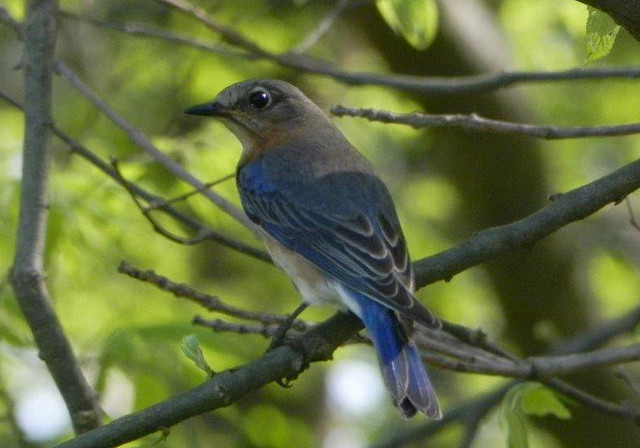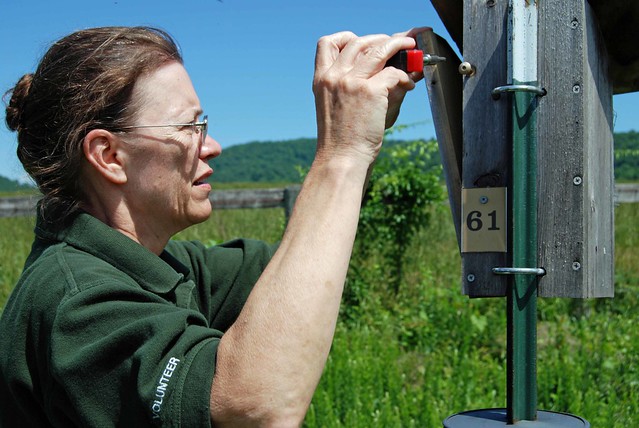Read Our Blogs
Bluebirds at Sky Meadows State Park
Even in the cold of winter at Sky Meadows State Park you may see bluebirds flying around the park. Thankfully, our bluebirds have plenty of spaces to nest, lay eggs, incubate, and nurture their babies.
Female Eastern Bluebird at Sky Meadows State Park
You may have noticed bird houses lining the side of the road as you drive down Edmonds Lane along the park entrance. These are just a few of the bluebird houses installed, maintained, and monitored by the Shenandoah Chapter of Virginia Master Naturalists following the bluebird housing standards of the Virginia Bluebird Society. Led by Master Naturalist Margaret Wester, this team has installed 96 bluebird houses throughout the park which provide nesting spaces for bluebirds and other native birds like Tree Swallows.
Commenting on the importance of this initiative, Margaret stated “A big decline in the Bluebird populations was noted by scientists and others not long after WWII and the big development boom, especially around the 1950’s and 60’s. Concerned organizations and citizens started developing and putting up nesting boxes and over the years with continuance and expansion of bluebird trails (nationwide plus Canada), the bluebird populations have recovered and are no longer endangered. That is why it is an important conservation practice to provide, monitor and maintain bluebird nesting boxes.”
Members of the Shenandoah Chapter of the VA Master Naturalists pose next to a newly installed bluebird nesting box
The bluebird houses at Sky Meadows State Park play a critical role in providing nesting space for our native bluebirds. For Bluebirds, finding a proper place to lay a nest is not as simple as finding any old branch and laying down some twigs. Bluebirds are cavity nesting birds, meaning that rather than simply building their own nest from scratch, they seek out existing holes and cavities in which to lay eggs. Often these holes are made from other animals like woodpeckers found primarily in dead trees.
As suburban development continues to grow and more dead trees are removed from the local area, bluebirds have a difficult time finding natural cavities for nesting.
Monitoring volunteer opens one of the boxes
While making plenty of bluebird houses available is an important way to support a thriving bluebird population, the work does not end there. In addition to installing bluebird houses, the Virginia Master Naturalists and their volunteers proactively maintain the houses and seek to optimize bluebird nesting success by keeping track of bluebird nesting activity. They do this through bluebird house cleaning, removing pest insects and other invaders, carefully tracking the bluebird nesting activities, and performing other duties to ensure the best living conditions for our bluebirds. 
Since the bluebird houses were first installed in 2011, the Virginia Master Naturalists have recorded a total of 1,663 bluebird and 1,252 tree swallow fledglings who were raised in the bluebird houses at Sky Meadows, clearly showing the impact of their work.
At Sky Meadows State Park, bluebirds are an important part of a complex ecosystem. The collaborative efforts of Sky Meadows, Master Naturalists and their volunteers help to support a thriving population of native bluebirds, thus helping to preserve the rich natural diversity of the Crooked Run Valley as a whole.
We're thankful for our park volunteers and couldn't do what we do without them.
If you're interested in volunteering and want to learn more about the Virginia Master Naturalist Program click here, and specifically about the Shenandoah Chapter here.
If you have read the article and have a question, please email nancy.heltman@dcr.virginia.gov.
Search for blogs
By Park
Categories
Cabins
Camping
Fishing
History and Culture
Other
Programs and Events
Trails
Volunteers
Water Fun
Archive
2025
2024
2023
2022
2021
2020
2019
2018
2017
2016
2015
2014
2012
















